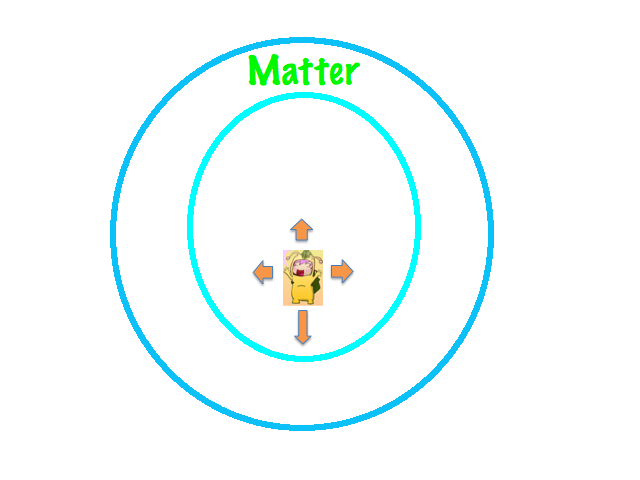Editor’s Note: The following post is written by a friend of ours, Justin Sipes. Justin’s currently pursuing a degree in chemistry from the University of Texas at Dallas.
For every fictitious universe there are natural laws that must be applied or relaxed in order to make the universe function according to its creator’s design. The universe in which InnerSpace takes place is not immune to this and, as such, one must examine where the game becomes inconsistent with reality and how it address these inconsistencies. I’d like to examine the challenges gravity imposes on this universe and how these challenges might be faced.
Previous blog posts have stated that in the “bubble worlds,” gravity pulls objects away from the center of the spherical worlds, towards the edge where the land is. This feels unintuitive to many people, as the only hands-on experience most will ever have is Earth’s gravity pulling objects to its center. Yet, were one to apply a more general understanding of gravity, does the gravity of InnerSpace stand up to scrutiny? The answer turns out to be a mixture of yes and no.

What Goes Up…?
Gravity is the name given to the phenomenon of matter’s tendency to attract other matter. For most cases, the gravitational force between two bodies can be taken to be proportional to the product of their masses, while also being inversely proportional to the square of the distance between the bodies. What this means is that objects with more matter cause greater gravitational attraction, and the force increases drastically as the bodies draw closer. This becomes more complex when one of the bodies is in a shell formed by the other body, such as in the bubble worlds of InnerSpace.
Let’s start with a simplified version of this universe from which we can extrapolate where issues might arise. For this example, consider a single bubble world that lies at the center of mass of this universe. If we place an object at any point within this world, it is surrounded by matter and has a gravitational force pulling it every direction. However, this can be simplified by breaking down the forces into their 3-dimensional components: back and forth, side to side, and up and down. Each gravitational interaction is made up of combinations of these directional components. Being within a sphere, nearly every gravitational interaction is going to be canceled out by another interaction from the other side of the world. In fact, if the object is not in the center of the world, only one component of all of these interactions will not be fully cancelled out: the direct “downward” force that draws the object towards the point on world’s edge to which it is closest. This is because the object is farther from the other side of the world, causing this opposing force to be much weaker, as one would expect. In this simplified universe, gravity would indeed work as the creators of InnerSpace have designed. The following illustation helps to give one an idea of how this works.

Warning: scientist art.
When one takes into account that this universe is populated with many bubble worlds, the gravity of the situation becomes a little more complex. Since not every one of these worlds can be at the center of mass of the universe, certain worlds will have uneven amounts of matter surrounding them, which, given enough displacement from the center of the universe, could cause these directional forces to not cancel out properly and force all matter in the bubble to one side of the world. If gravity is to behave the same in each world, this is an issue that must be addressed. Expanding the scope of our analysis past the edge of these bubble worlds creates its own set of issues. Firstly, a universe of sufficient size that is full of matter with no empty space is going to, thanks to gravity, compress into a super-dense singularity, allowing no opportunity for bubble worlds to exist. Secondly, supposing the mass of this universe is not enough to cause that to happen, there must be some mechanism in place for these worlds to avoid collapsing in on themselves due to gravitational interactions between opposing sides of the bubble.

The Fiction of Science
Thankfully, suspension of disbelief is a powerful tool that allows universes like these to operate in the mind of those experiencing the product of their creator’s efforts, and addressing issues people might have with one’s work helps facilitate this. For Star Trek, the “Heisenberg compensator” is introduced as a solution to the Heisenberg uncertainty principle’s kibosh on teleportation. In Mass Effect, nearly any deviation from the natural laws of the universe is written off with mass effect fields. In InnerSpace, there exist opportunities to explain why this universe exists and behaves the way it does which will help facilitate one’s appreciation for the unique situation. It has been stated that in this world, ancient civilizations had previously existed that built great structures and developed strange technologies. One of these civilizations could possibly have developed a sort of “gravity pump” which redirects gravitational attraction through different dimensions, allowing a stable, desirable gravitational environment to be maintained. Another solution could be the existence of an arcane anti-gravitational force unique to the universe, which allows bubble worlds like the ones present in the game to exist.
Given that this is a work of fiction and properties of physical laws is not the primary focus of the game, solutions do not need to be fully realized, yet the identification of and effort put forth to resolve issues in the world one builds is the trademark of a team that’s passionate about its work. Look forward to exploring the universe PolyKnight Games creates in InnerSpace and how they overcome the various challenges that come with it.

we got’s to much dark energy and not enough dark matter brah 😛